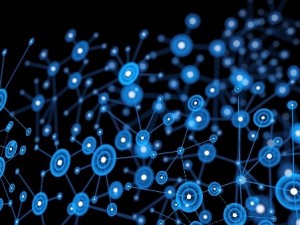Two topics seem to be top of mind this year…the long awaited “Star Wars, The Force Awakens” and the “Internet of Things.” Being a fan of both, I think there are some striking parallels to think about. So here is a mashup of Star Wars references to describe the Internet of Things… its value… as well as some enabling technologies.
“The Force is everywhere and binds all things together”…. Interconnectedness
 Both the ‘Force’ in Star Wars, and the ‘Internet of Things’ (IoT) deal with the concept of interconnectedness. The IoT is a network of connected devices, machines, and sensors that can generate and share streams of data. This network is rapidly expanding to include everyday objects such as appliances, wearables, electronics, autos, as well as location-aware sensors in the environment where we work, play and shop.
Both the ‘Force’ in Star Wars, and the ‘Internet of Things’ (IoT) deal with the concept of interconnectedness. The IoT is a network of connected devices, machines, and sensors that can generate and share streams of data. This network is rapidly expanding to include everyday objects such as appliances, wearables, electronics, autos, as well as location-aware sensors in the environment where we work, play and shop.
In their recent report on the Top 10 Technology Trends for 2016, the Gartner Group describes this as a digital mesh of devices and continuous streaming data that surrounds us and is everywhere.
“May the Force be with you” … It’s here, right now
In fact, there is a good chance ‘Internet of Things’ is already with you… perhaps on your wrist, in your car or in your home. The IoT ecosystem also includes the mobile devices that we all carry with us. So this interconnectedness goes beyond machine to machine… to include people, places and things.
One of my favorite IoT devices is a wearable ring from a company called Ringly. The jewelry can vibrate and flash lights in different patterns to notify a woman of certain phone calls, alerts, messages. It can even tell her when her Uber has arrived!“The Force Awakens”…Marketers are awakening to the power of the IoT.
In a previous blog post of his, my colleague John Balla explored the enormous opportunities that IoT present to impact the customer experience - generally falling into one of two categories:
- The ability for users to access the information from the device, and
- For marketers to gain real-time insights into the needs and behaviors of the device users.
I would add a 3rd opportunity to that list - the ever increasing number of touchpoints that can be used for consumer engagement. Items in our environment such as digital billboards and in-store signage can be personalized based on who is driving or walking by. And everyday objects such as smart watches, appliances, and autos can become touchpoints for marketing and/or customer service. For example, your smart car can transmit real time data to be analyzed to determine if the car needs maintenance. It can then not only alert the owner, but also alert auto service shops in the area, who may in turn compete for the business. These new channels mean that marketers will be able to become embedded in a customers’ life through real time alerts, notifications, offers, and product replenishments. Those that do it well and improve the customer experience could become virtually irreplaceable.
“Ready are you?” … Enormous amounts of data are coming your way
According to Gartner, by 2020, 25 billion devices will be generating data about almost every topic imaginable. And IDC predicts that by 2020 IoT will drive nearly as many digital bits are there are stars in the universe.
Of course this means that companies need new approaches to monitor, analyze, and take real time actions based on these enormous data volumes. Following is a list of 4 technologies that can help companies to get value from the Internet of Things.
- “Listen to the force, Luke”…Event Stream Processing
Only a small portion of the data is relevant and actionable. Event Stream Processing can help companies ‘listen’ to the streaming data and sense when something occurs …a ‘disturbance in the force’ so to speak…that may require an action or decision to be made. My colleague Andrea Sangalli did a nice job of describing the link between event stream processing and the Internet of Things in this blog post.
- "Yes. Always in motion, the future is.” … Continuous Analytics
Analytical tools and algorithms will be needed to make sense of the data in while data is being produced…while the data is in motion, and before it’s stored. Again, this is where Event Stream Processing becomes important - to enable this real time analysis and visualization of data without disrupting a company’s existing systems.
- “It is our decisions that shape our destinies”… Real Time Decisioning
In response to IoT data, decisions also need to consider historical data in order to account for the complete relationship with the customer. Decisions need to be made in real time and with ‘Jedi-like speed.’ In today's earth-bound yet complex business world, Jedi-like speed is best approximated with SAS Real Time Decision Manager.
- “A Jedi uses the Force for knowledge & defense, never for attack”… Data Security
The Internet of Things can provide valuable data however there is a dark side as well as a light side. The light side will use the data gain greater knowledge, and better serve customers with more personalized experiences, while the dark side poses data security risks. Considering how the bulk of big data is customer data, the question of data security is not a trivial matter, especially when considering privacy concerns with data. You can delve deeper into this question of balancing personalization and privacy in this free whitepaper.
Given all that, how prescient was C3PO when he said, “R2D2, You know better than to trust a strange computer!"

